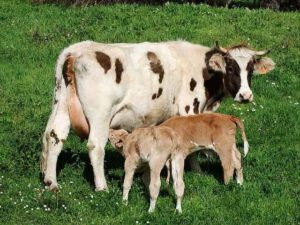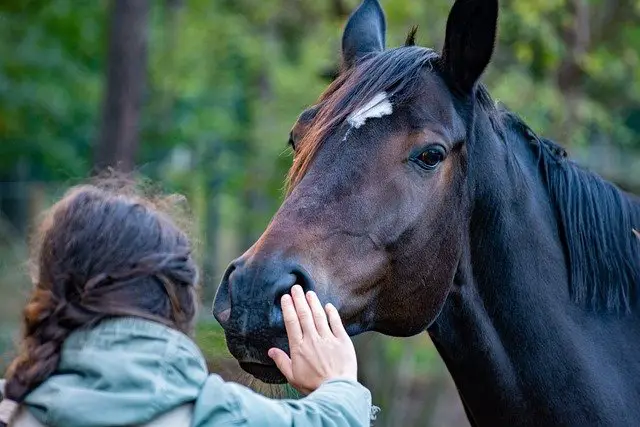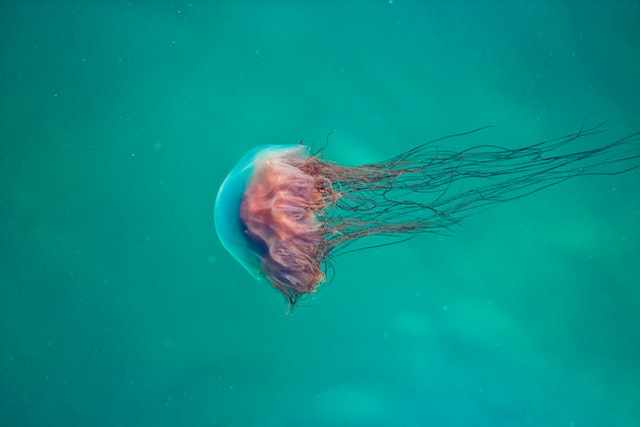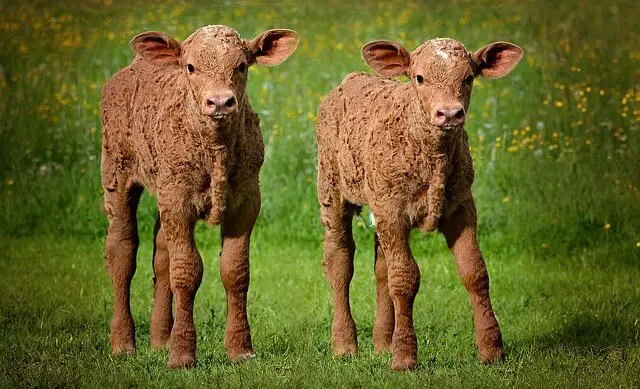Can Cows Have Twins? (Everything You Need to Know)
In most cow deliveries, only one calf is expected. However, recent events have shown that it is also possible for a cow to have multiple births, even though this rarely happens. Given the challenges that often accompany cattle twinning, it is not unusual for herders to be concerned about the fortune of their pregnant cows. So, can cows have twins?
Yes, cows can have twins. This mostly occurs when the cow has double ovulation, which is often caused by a reduction in progesterone levels.
The progesterone level is characterized by feed intake and the cow’s body condition at the time of breeding. Other factors that may affect twinning include the age of the cow, genetics, milk production, and seasonality.
So far, reports show the rate of cow twins is still nearly insignificant, with popular estimations being around two percent of all cattle pregnancies. But recently (in the last 25 years), there seems to be a surge of twinning in certain cow breeds like the Holsteins. In most cases, twin calves develop from a split embryo so their relationship is usually fraternal and not identical.
While twinning can be beneficial, it can also come with health issues not just in the calves but also in the mother cow. There’s also a good chance the calves will die before birth (abortion).
In this article, we will explore various aspects of cow twin births such as the causes, benefits, consequences, care tips, and possible health implications.
NOTE: Miscarriage in cattle is regarded as abortion.

Can Cows Give Birth to Twins?
Just like other cattle, cows can give birth to twins. But the odds of this occurring is somewhat astronomical. However, as a farmer, it’s better to be prepared than to be taken unawares.
Giving birth to twin calves can be either positive or problematic depending on the circumstance surrounding the arrival of the carves. If both calves are the same sex and are born alive, and there’s an extra cow available to act as a foster parent to one of them, then twinning can be beneficial. Unfortunately, 90 percent of the time, this doesn’t happen.
Twin calves often come mixed (male and female), and in many cases, either one of them arrives dead or both. And the affected cow is usually difficult to rebreed.
Once a cow has given birth to twins, her odds of conceiving twins again is usually high. In other words, one cow can have twins up to three times. This is commonly observed in dairy breeds and can pose serious health risks.
Due to the challenges often associated with raising twins, it’s very important to understand how they develop, so you can figure out the best way to manage them. Specifically, you should be able to nurse them properly.
What Causes Twins in Cows (and Cattle)
Twinning in cows and cattle can be attributed to double ovulation or the splitting of an embryo in the early stages of development.
This is often subject to a number of factors in the environment, and even genetics. Some of these include age, body condition, milk production, feed intake, and genetics. Let’s look at each one in more detail.
- Milk Production
One of the major factors that can influence double ovulation in cattle, especially dairy cows, is milk yield.
A high milk yield just before heat or natural oestrus increases the chances of double ovulation. This typically occurs in the last two weeks.
As heartbreaking as this may sound, milk production in cattle has greatly increased in recent years due to higher demands. This has also led to an increase in the rate of twin birth.
This trend is less likely to change in the coming years, which can present a problem for producers. To this end, more effort should be made in identifying ways to prevent or manage twin calves more effectively.
Twinning tends to be more common in dairy cattle. Studies show that only about 1-2 percent of pregnancies in beef cattle end in twin birth. However, for dairy cattle, it can be up to 5-10 percent.
- Feed Intake
To increase milk yield, one of the more common strategies used by producers is increasing the feed intake of their cattle. Unfortunately, this often results in hormonal changes; specifically, progesterone levels. This is so because the level of progesterone in the bloodstream at any time is usually dependent on the amount of feed the cow consumes.
To put it more simply, when a cow consumes more feed, the flow of blood through her liver increases, which in turn cuts down on her level of progesterone.
Studies show that this decrease in progesterone levels can influence ovulation leading to the birth of non-identical twins.
Thus, we can comfortably say that the chances of twinning increase with higher feed intake. This explains why twin birth seems to be on the increase among lactating Holstein Friesian cows.
Do this mean you should cut down on your cow’s feed? Of course, not. While this will greatly reduce the chances of double ovulation, it will affect the cow’s yield and your profit.
- Body Condition
Another thing that can affect a cow’s fertility is her body condition.
Cows that are well-conditioned are usually more fertile and have a higher risk of double ovulation. However, this highly depends on the cow’s previous condition before the time of breeding.
First, this can be influenced by nutrition as described above. For instance, a thin calf can be made to consume a lot of quality feed which may likely result in increased body condition.
In the same regard, a pregnant cow can lose her calf, and become overweight as a result. In this case, she has more chances of ovulating twice in a single cycle.
- Age of the Cow
A cow’s age can also influence her fertility.
Experience shows that cows with a long history of calving or lactation usually give birth to more twins as opposed to heifers.
In other words, twinning tends to increase with the parity of the cow. So, as a cow gets older and bears more calves, her propensity to have twins also increases.
The reason why this is common with older cows is that the risk of double ovulation increases as calving numbers go up.
This is also associated with the capacity of the uterus to accommodate multiple embryos. It is believed that the uterus in younger cows and heifers doesn’t have sufficient capacity to support two embryos. As a result, embryo mortality tends to be higher in heifers.
On the other hand, the uterus in older cows is more developed to support more than one embryo at the same time.
- Genetics
Studies show that genetics also has a strong influence on the incidence of twinning.
Cows from a family line of twinning dams have a higher chance of having twins themselves. In other words, twinning runs in cattle families just as it does in humans.
This phenomenon is commonly observed in certain cow breeds. A good example is the diary Holstein Friesian. Existing records show a higher incidence of multiple ovulation and twin births in Holsteins more than any other cattle breed.
Generally, the chances of twinning are far higher in dairy cattle than in beef cattle.
Consequences of a Cow Having Twins
Unlike sheep and deer, cows are meant to carry only one calf at a time. So, even though an extra calf may seem like a big win, it could actually become a bummer in the long run.
Here are some of the problems and challenges that can arise from twin births.
Increased Mortality & Reduced Weight
Studies show that, in cattle, abortion happens more frequently in twin pregnancies than single ones. This pregnancy loss may occur at gestation or immediately after the birth of the calves.
Even if the calves are born alive, there’s a good chance one will be weak or both. This is understandable since cows with twins usually calve earlier than they should, which results in reduced birthweight. In this case, the calves are born before they are fully matured.
This anomaly is often linked to differences in nutrient transfer to the calves due to unequally sized placentas.
Weak calves can also be a product of a stressful birth process. This could happen due to displacement of the calves from their normal positions in the birth canal.
Extended Calving Periods
It is also common for cows with twins to have extended calving period. This can be caused by a number of factors. Some of which include increased suckling pressure, stress from twin delivery, and low energy levels.
Consequently, the cow doesn’t usually recover in time for the next breeding season. The best way to combat this is to wean the calves early so as to allow the cow more time to recover and join the rest of the herd.

Reduced Post Milk Production
With multiple births, there’s a higher demand on energy by the nursing cows to maintain their body condition. This can be as much as 15 percent increase.
The increased energy demand commonly arise when the cow tries to feed both calves. Unfortunately, this demand is rarely met. As a result, the cow has low energy levels.
Besides the cow not being able to rebreed quickly, this can also affect her ability to produce enough milk the next time she lactates.
Calve Rejection
Another problem that can arise with twin births is a situation where the cow prefers one calf and rejects the other.
This is often linked to the cow’s inability to supply all the nutrients required by both calves.
To increase the chances of survival, early intervention is important. Most times, this will involve increasing colostrum supplementation, and/or adopting the rejected calf to another dam or cow.
Retained Placentas
Being smaller in size, twin calves are usually born earlier than whole calves. As a result, the risk of retained placenta and other infections in the cow is higher since the tissues are still underdeveloped and take more time to slough off.
Cows with retained placentas can be given a shot of selenium.
Freemartin Heifer
Experience shows that about half the percentage of cattle twins consists of male and female calves. Over 90 percent of the time, the female or heifer is sterile and is known as a “freemartin”.
Freemartinism occurs as both calves share the same uterus and placenta circulation which results in joint blood circulation and transfer of hormones from the male fetus to the female fetus. Consequently, the female reproductive tract is altered leading to abnormalities.
There are several ways to check if a young heifer is a freemartin. This includes physical signs such as a small udder and teats, an enlarged clitoris, plenty of hair in the vulva region, and so on. To find out more, check out our post on how to tell if a heifer is a freemartin.
Benefits of Cows Having Twins
Cow twinning can also be beneficial if everything goes right, which seldom happens.
If both cows are born normal and raised with the help of an extra cow, they can be used for meat or breeding purpose depending on their sexes. If both calves are females, then you can raise them for production or sell them as replacement heifers if they are not born with any significant deficiency.
The same applies to the male sex; if both calves are bulls, then you can consider raising them for breeding purposes or just use them for meat.
The idea is to consider the cost of raising the calves. If they won’t amount to any use in the future, then it’s pointless raising them.
In the case of male and female twins, the females are most freemartins and are better used for meat since they are infertile. There’s no point raising them.

Can a Cow Raise Twins?
Yes, but this is rare. This is tied to the amount of colostrum (maternal milk) the cow can produce at a time. Most cows produce just enough for one calf.
So, in the case of twins, the mother usually picks one of the calves to nurse and rejects the other. You could get another cow to provide milk for the rejected calf.
However, this itself can present a challenge as not all cows will accept to milk a newborn that is not theirs. You just have to pray she’s willing and doesn’t kick off the calf. Don’t try to force her because it won’t work!
That said, even when a mother chooses to milk both of her twins, it will likely result in lower energy levels due to the increased suckling force on her. As a result, she will take longer to rebreed.
Thus, having a cow raise twins is possible but not recommended, especially if you plan to rebreed her for the next season.
Caring for Cows and their Twins
Newborn twin calves need a lot of colostrum and vitamins to supplement their weak immune systems.
Unfortunately, most of the time, the cow mother doesn’t usually have enough for the two calves, which is why she often nurses one and rejects the other. In this case, an additional supply of commercial colostrum becomes necessary to ensure both calves survive.
Even in cases where the cow is able to nurse both calves, it’s still recommended to get them an extra bag of colostrum for both calves.
You should also increase the quality of the cow feed by adding extra vitamins, specifically, vitamin A, D, and E. As earlier indicated, giving her a shot of selenium can help if she has conditions such as retained placenta or mastitis.
Ideally, talk to a vet before you you finalize whether or not to keep both calves after birth.
Conclusion: Can Cows Have Twins?
So, what do you think? Can cows have twins? Yes, they can, especially dairy cows. But this is rare, and shouldn’t be encouraged because of the accompanying health risks.
Having said that, twinning cannot be prevented in most cases. So, depending on their status, you can either raise them as producers or keep them for meat.
But I want you to be aware of the extra work that usually goes into birthing, fostering, and managing an extra calf. Sometimes, this might not be a good move, especially if one of the twins is a freemartins heifer.
I will draw the curtains. Cheers to a good breeding season and no twin loss!
Recommended Resources:
https://www.dtnpf.com/agriculture/web/ag/livestock/article/2020/12/29/many-twins
https://www.progressivecattle.com/topics/herd-health/understanding-the-cause-and-impact-of-twins
https://amp.abc.net.au/article/11536848
https://farmhouseguide.com/can-a-cow-have-twins-and-nurse-two-calves/#Do_Cow_Twins_Usually_Survive





